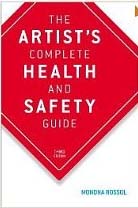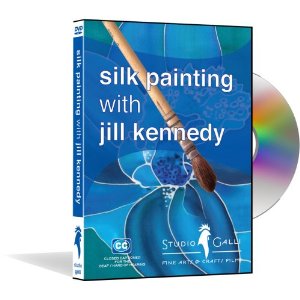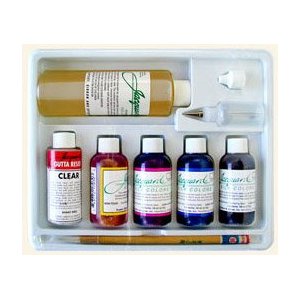I am interested in asking other people who use Dupont Dye if they have had any trouble with bladder cancer
Message: I am interested in asking other people who use Dupont Dye if they have had any trouble with bladder cancer. My artist friend who has used these products for 20+ years is now recovering from this. There is a lot of info about this generally on the internet, but not much specifically, so I am reaching out.
by Monona Rossol
I think that the Dye Forum would be a good place to ask your question. The H. Dupont silk painting dyes contain many different types of dye. It is possible, though we don't know for certain, that they may have contained benzidine-based dyes at some point in the past. Commonly available all purpose dye certainly did thirty years ago, though now they no longer do, and fiber reactive dyes do not. I don't know if you've already seen my posts and blog entries about bladder cancer, or my posts about H. Dupont dyes.
Almost all of the dyes in the H. Dupont silk dyes are trade secrets. The manufacturers do not reveal to anyone what ingredients they use. You can request MSDS (Material Safety Data Sheet) pages for the current formula of any dye you buy now, many of which turn out to be rather uninformative, indicating that the manufacturers claim that there are no hazardous ingredients; however, you can never find an MSDS for any old formulation of a dye color, and we don't know when or how many times the manufacturers have changed their formulas. Current MSDS pages are required to mention carcinogens that are present at or above 0.1% of the formula, but I fear that there may be no requirement for MSDS pages to be made available for older versions of substances that have been reformulated, once they are no longer being sold. (Only legal action can help with that.) Here is a link to a post containing everything I know about the ingredients in the H. Dupont and similar dyes, which are known collectively as the French silk dyes:
These lines of dye for silk painting mostly contain acid dye and/or basic (cationic) dye, but they can, it turns out, contain almost any sort of dye in some of their color formulas.
We know that all-purpose dyes, including the ones commonly sold in grocery stores, contained carcinogenic benzidine-based acid dyes at least through 1981; see, for illustration, a short article in the July 1982 issue of Mother Jones magazine through Google Books. An important US government document, "Health Hazard Alert--Benzidine-, o-Tolidine-, and o-Dianisidine- Based Dyes" (NIOSH ALERT: December 1980; DHHS (NIOSH) Publication No. 81-106), summarizes the evidence against the benzidine-, o-tolidine-, and o-dianisidine-based dyes that are believed to cause bladder cancer. A more difficult-to-read 1991 journal article about bladder cancer among dye factory workers, "Bladder cancer mortality of workers exposed to aromatic amines: an updated analysis", by G. Piolatto et al [PDF], lists figures for the actual risks of heavy exposure to the dye chemicals benzidine, naphthylamine, fuchsin, or safranine T.
Since we are pretty sure that H. Dupont dyes include acid dyes or basic dyes, and that some formerly commonly used acid dyes and direct dyes were based upon benzidine, o-tolidine, or o-dianisidine, it does not seem unlikely that some colors of the H. Dupont and other secret-ingredient silk painting dyes may once have contained similar hazards. We have no idea when the formulas may have been changed so that this line of dyes no longer contained them. Supposedly, the H. Dupont Silk Dyes were first introduced more than a century ago. MSDS pages have been required only since November 25, 1983, though some existed earlier; I'm inclined to doubt that any MSDS page existed for H. Dupont dyes before then.
Here is a list of dyes that probably cause bladder cancer, from The Artist's Complete Health and Safety Guide, by Monona Rossol, pp 137-139, but with no way to tell which if any of the H. Dupont dyes ever did or still do contain them. Most dyes based on benzidine, o-dianisidine, or tolidine are either acid dyes or direct dyes, so it seems not unlikely that the formulas for H. Dupont dyes and other silk dyes may have contained some of these dyes before 1981. The acid dyes in question include Colour Index acid orange 45, acid orange 63, acid red 85, acid red 89, acid red 97 Scarlet G, acid yellow 42, acid yellow 44, acid red 114, and acid red 167, in addition to a large number of direct dyes. Benzidine-based dyes seem to have been mostly phased out in the US for safety reasons, but the same is not necessarily true for dyes based on o-dianisidine or o-tolidine, which are suspected of producing the same dangers. I think that dyes based on any of these chemicals should be included in a current MSDS, so an MSDS with nothing of interest included in it probably indicates a dye that does not contain them, but I am not certain whether this is universally true.
It's extremely difficult, or impossible, to get any information from a manufacturer who is afraid of legal ramifications. Here is an example of what happened when someone tried to find whether a certain dye made by another dye manufacturer had caused a specific illness:
The dye company refused to give even the full Color Index name of the dye in their product, such as "Acid Red 94"; they gave only the infuriatingly useless information that it contained "Acid Red", without the number that is needed to make this a specific Colour Index name. "Acid Red" without a number could refer to any of hundreds of different dyes, ranging from toxic to totally harmless.
Here are links to my blog entry with a question about fiber reactive dyes from a reader who has bladder cancer and uses a different type of dye than the Dupont series:
and my discussion of benzene and benzidine in fiber reactive dyes:
Although these questions specifically refer to fiber reactive dyes, which as a class seems to be safer than some other dyes, there is also some more general information in them.
Does your friend remember using any other dyes or other likely carcinogens during the nineteen-eighties, such as all-purpose dyes as they were then, cigarette smoke, factory work with chemicals, working as a hairdresser, or exposure to the polycyclic aromatic amines in tattoo ink? Or did she use only H. Dupont dyes? As you already know, the development of bladder cancer often takes twenty-five years or longer after the exposure to the carcinogen, which makes it more difficult to decide what chemicals are most likely have been to blame. With bladder cancer, the development of the disease occurs gradually, in steps, with first one mutation accumulating in the DNA, and then another; it takes a combination of several changes to occur in the same cells for a cancer to begin growing. This means that a person with bladder cancer is at risk for developing new bladder cancers, and must be careful to avoid further exposures to known bladder carcinogens.
If your friend is still working on her art, she will need to know which materials do not place her at additional risk, as she may be especially susceptible to new bladder cancers if she continues to be exposed to chemicals that cause bladder cancer. As far as current and future use of silk dyes is concerned, it seems likely that the H Dupont Dyes do not now contain benzidine-based dyes, and so they should be safe to use with appropriate precautions, such as always wearing gloves to avoid skin exposure, and never eating in the dye studio. (Common advice is also to avoid smoking while using dyestuffs, since artists commonly ingest small amounts of their materials as the result of smoking while working, but of course cigarette smoke is itself a major cause of bladder cancer, and also makes it much more likely that benzidine-based dyes and other carcinogens will succeed in causing cancer.)
To be more certain about the identity and therefore the safety of dyes used for silk painting, I personally feel more comfortable with using dyes whose ingredients are known, such as the Procion H or Remazol (vinyl sulfone) fiber reactive dyes, which are often used for silk painting. (See "About Procion H dyes" and "About Vinyl Sulfone Fiber Reactive Dyes".) None of the Procion H or vinyl sulfone dyes or any other fiber reactive dyes have ever contained dyes based on benzidine, o-dianisidine, or o-tolidine, as far as I have been able to discover. You can also mix your own silk paints from pure acid dye powders supplied by Jacquard Products, PRO Chemical & Dye, or Dharma Trading Company, which provide full information on which exact dyes have been used to mix the colors in these lines of dye (though they don't tell which of these dyes have been used to mix a specific color). Knowing the Colour Index name of each dye is the only way to be sure what hazards you are being exposed to.
When you are using a premixed dye whose ingredients are secret, such as H. Dupont Silk Dyes, Sennelier Tinfex Design, Pebeo Soie, and Kniazeff, you can never have much of an idea of the exact hazards you need to be careful to avoid, though the more dangerous chemicals ought to show up on the MSDS you request for each dye from your dye seller.
Best wishes to your friend in his or her recovery from bladder cancer.
If any silk painting readers have experienced bladder cancer, in their own lives or among their friends, relatives, or colleagues, please join the Dye Forum to discuss whether there's a possible connection with the old formulas of all-purpose dye, direct dye, or any of the French silk paints.
(Please help support this web site. Thank you.)
(Please help support this web site. Thank you.)
Posted: Friday - December 02, 2011 at 08:00 AM
Follow this blog on twitter here.
Quick Links
- All About Dyes & Dyeing Top -
- Top of this blog -
- FAQ -
- The Dye Forum -
- How to Tie Dye - How to Batik -
- Books - Toys - Plants -
- Top of this blog -
- FAQ -
- The Dye Forum -
- How to Tie Dye - How to Batik -
- Books - Toys - Plants -
More in this category:
- -
Statistics
Total entries in this blog:
Total entries in this category:
Published On: Aug 29, 2012 02:49 PM
Total entries in this category:
Published On: Aug 29, 2012 02:49 PM


